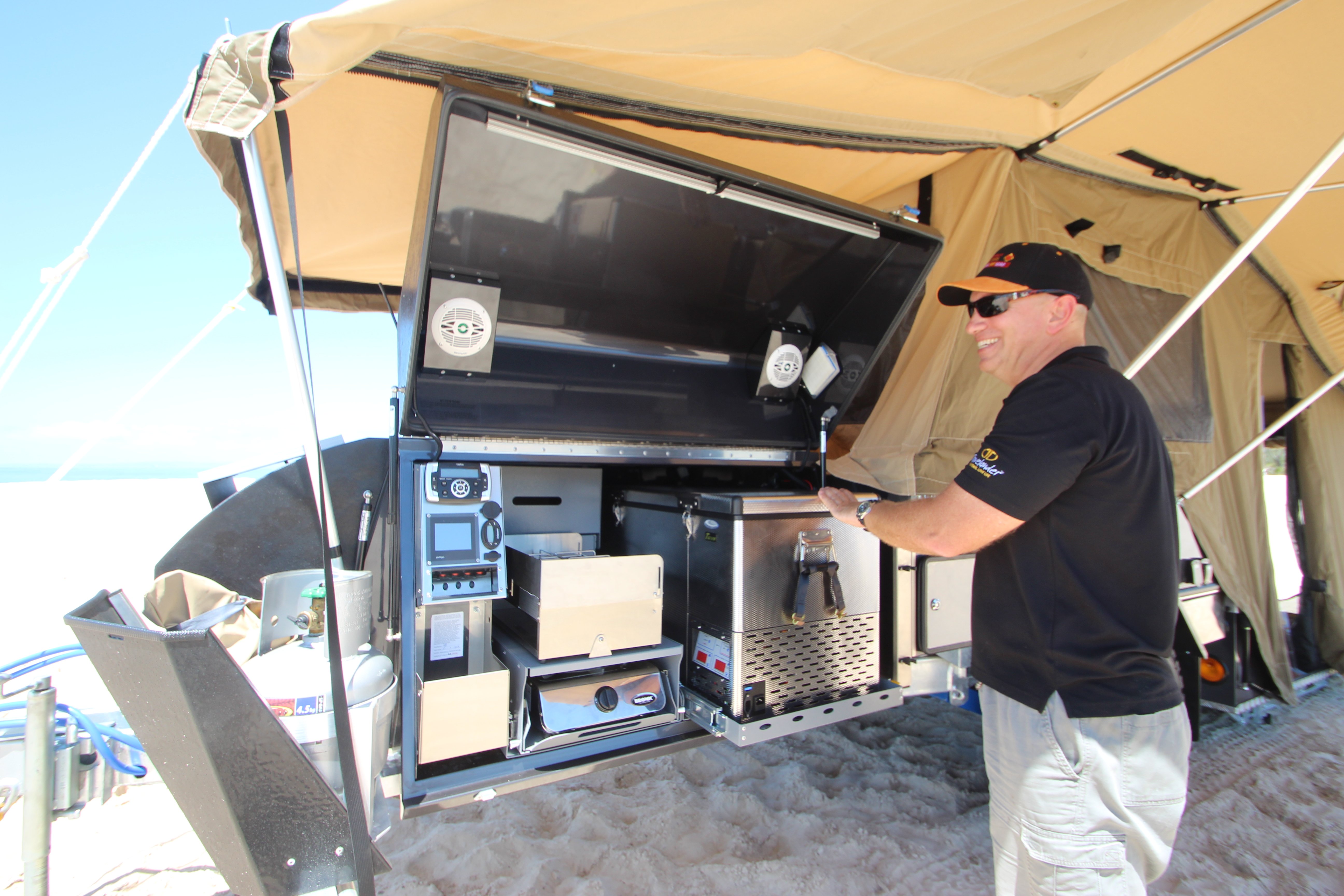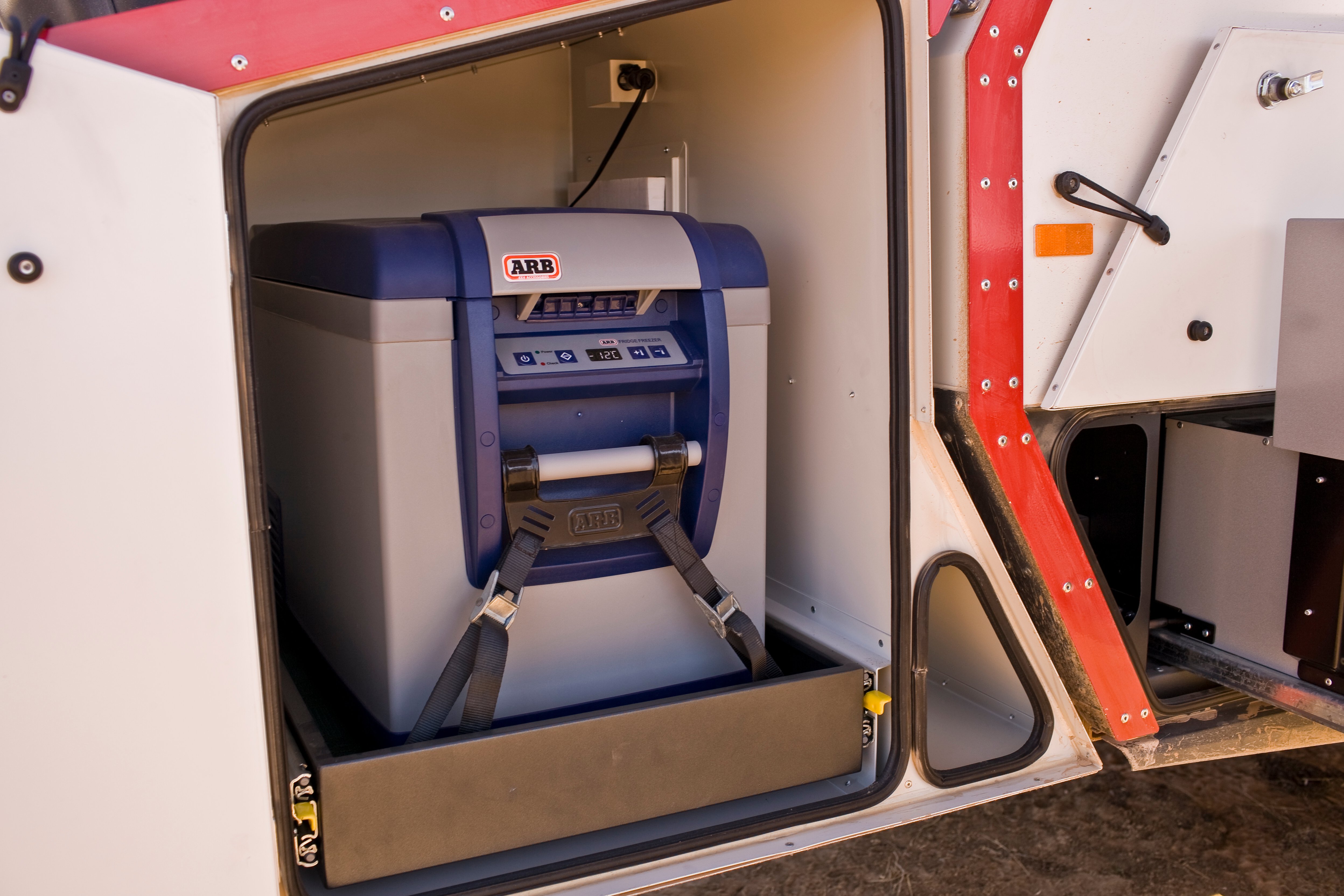Advertisement
Advertisement
A show of hands: Who owns a 12V fridge and wouldn’t head bush without one again? Yep, my hand is pointing to the sky too. Now, while having a fridge/freezer parked in the back of your four-wheel drive or camper trailer is a huge advantage when off the blacktop, have you taken the time to think about how you can enhance the performance of your chosen fridge?
It doesn’t matter which make or model you own, these following nine tips will guarantee your food and drinks stay cooler for longer.
Sadly, factory 12V accessory points commonly found in the cargo bays of modern four-wheel drives use wiring that is too thin to handle the loads of a greedy 12V fridge. By increasing the size of these cables, more current can flow to the fridge. Simple, right?
Think about it like a hose with water flowing through it – a bigger hose will allow more water to flow. Selecting wiring that is too thin to run a power-hungry device (like a fridge) could be described as driving your vehicle with only two cylinders running. It should start, but it won’t perform very well at all.
Many experts recommend installing 6mm twin-core wiring for fridges, and I’m not here to disagree with this. In fact, for my own vehicle I have gone with larger 8mm twin core wiring – as I firmly believe overkill is a good thing when it comes to 12V wiring. This also gives me scope to power other accessories such as camp lighting in the future.
If your fridge was supplied with a transit cover, use it. If one wasn’t supplied when you bought your fridge, but there is the option to purchase one, do so! Here is a hot tip: Use this as a negotiating tool when shopping. “I’ll pay cash now if you throw in the transit cover.” I guarantee you this will result in a sale. Fridges need all the help they can get, so by installing a cover you are not only protecting it from bumps and scratches (transit bags are usually padded); but these covers also prevent direct sunlight from touching the fridge surface, in turn keeping the fridge cooler and making it run more efficiently.

As mentioned earlier, the hotter your fridge cabinet is the harder it has to work to keep cool. This then means the fridge will be drawing more power from the battery in an attempt to outdo Mother Nature. A cheap trick I have been employing is putting a reflective windscreen sunshade or two over the top and sides of the fridge, paying particular care to not cover any vent (they need to breathe). For the minimal outlay, it is definitely worth the effort here. This technique alone could extend your battery life by a few hours.
Many fridges have the option to be plugged directly into 240V mains power. If you can get the fridge and its contents as cool as possible before securing it in your four-wheel drive or camper, the motor will not have to work so hard getting the temps down while you travel – the hard part is already done. I make the effort of putting both the starting and auxiliary batteries fitted to my Patrol on a battery charger before I leave too, just to know I’m heading away with a system that is working to full potential.
These simple steps will make the difference between a problem-free trip, and spending hours with your 4X4 running (wasting fuel) in an attempt to charge the batteries.

A person smarter than I once said: “You need to follow the five Ps when packing a fridge.” Proper Preparation Prevents Poor Performance. This is why vacuum sealing meat and pre-prepared meals like curries is a brilliant idea for anyone who is planning a few days on (or off) the road. This has two huge advantages, the first being that storage space is maximised as the vacuum sealer removes air from the packaging during the sealing process. Hence the reason it is called vacuum sealing.
Secondly, you can pop these pre-made meals or meats into your freezer overnight before the trip. These will act as ice blocks inside the fridge, further reducing internal temperatures and pressure on the compressor.
Remember when you were a kid and your folks would always yell at you for standing in front of the fridge with the door open while you waited to pick something to snack on? Well, there is a pretty obvious reason for that.
By leaving the door open, you are letting nice cool air out while allowing warm air into the fridge. Sure, it isn’t possible to always stick to a regimented timeframe surrounding when the fridge is open or closed … just think smart about how you use it. If you go to the fridge for a drink, ask if anyone else wants something at the same time. When preparing dinner or lunch, take everything you need out at once. The longer you can keep that door closed, the longer nice cool air is trapped inside where it belongs.

Deep-cycle batteries require a higher amp-hour rating over CCA (cold cranking amps), and vice versa for a starting battery. Think of the battery used to start your four-wheel drive as a sprinter in a running race. It is designed to push serious amounts of power in short bursts to get over the finish line as quickly as possible.
A deep-cycle battery, used to power low-draw accessories (such as LED lighting and fridges) is more like a long-distance runner. Endurance and lasting the distance via controlled bursts of speed is vital.
Basically, starting batteries aren’t designed to power accessories, and the constant state of charge-deep discharge (repeat, over and over again) will damage a starting battery quick smart. Deep-cycle batteries, on the other hand, handle these situations rather well.
When choosing an auxiliary battery, many suggest running a deep-cycle battery, or even a marine battery (commonly used to start boats). There are also hybrid batteries available that juggle the fine line between cranking and auxiliary roles. But why compromise? Unless you have space constraints, a dedicated starting battery plus a deep-cycle battery provides the best of both worlds.
Take a closer look at your fridge, and you will see vents on the outside of it. These vents feed cool air into the compressor, which is the heart of any fridge. A huge mistake many people make is packing gear too closely to these vents and blocking off airflow. This essentially chokes the fridge, dramatically reducing the lifespan of the internal components.
If you can’t easily fit your hands in the gap around the vents, you have packed it too tightly. Internal airflow is important too. As a rule of thumb, leave enough space for a six-pack inside the fridge cabinet. This allows cool air to pass throughout the fridge – resulting in cooler food and drinks without having to push the compressor as hard or for as long.

Traditional 12V CIG plugs are pretty much useless when it comes to powering a fridge. There, I’ve said it!
I’ve seen countless fridge cables that have melted such products as the particular socket supplied hasn’t been able to handle the loads placed on it. Another point worth mentioning: CIG plugs offer very limited mechanical bind in an accessory socket. What this means in the real world is they tend to pop out or wiggle loose while driving.
There aren’t many more infuriating situations in life than arriving at camp after a full day’s drive to find the fridge isn’t powered, your drinks are warm and your food is ruined. The solution here is to use what is called a Merit or Hella plug, or go to the effort of installing an Anderson plug. These have tremendous mechanical ‘grip’ – meaning they won’t pop off unless you really tug on them. It takes just a few minutes to swap them over, and a couple of dollars spent at the local electrical store to solve this once and for all.
Hopefully regardless of the make or model you have, these tips will help you to keep your food and drinks cooler for longer. Got any others we haven’t mentioned? We’d love to hear about them.